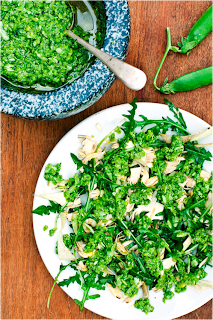I recently attended an event hosted by Good Energy and Arthur Potts-Dawson to encourage people to take a low-carbon approach to cooking. I am all for minimising the environmental impact of our activities and cooking uses an enormous amount of energy to power ovens, hobs, extractor fans, etc. I was keen to find out more about the campaign and of course have a go at some great new recipes.
Good Energy is the UK’s only 100% renewable electricity supplier and this is the second year in a row that they have teamed up with green chef Arthur Potts Dawson to run a campaign to teach people about low-carbon cooking.
Arthur said "From how we power our kitchen through to the choices we make about the food that we eat, we can all make small differences that can go a long way to positively impact our planet." I couldn't agree more!
Here are the recipes that were demonstrated at the event (reproduced with permission):
Raw Pea, Broad Bean and Violet Artichoke Salad With Wild Rocket and Dandelion
Serves 4
100g freshly podded peas
100g freshly podded young broad beans
4 young artichokes
25g wild rocket
25g wild dandelion
70ml virgin olive oil
45g Grana Padano cheese
1 small clove of garlic
1 small wedge of lemon
10g fresh basil leaves
salt and pepper to taste
To make the dressing:
100g freshly podded young broad beans
4 young artichokes
25g wild rocket
25g wild dandelion
70ml virgin olive oil
45g Grana Padano cheese
1 small clove of garlic
1 small wedge of lemon
10g fresh basil leaves
salt and pepper to taste
To make the dressing:
Pound the garlic in a pestle and mortar with a pinch of sea salt until smooth, then add the basil and continue to crush and smash until you have a smooth green paste in the bottom of the pestle. Now begin to add the peas and broad beans, one handful at a time, making sure that with each handful you have sufficiently crushed the previous handful to a rough paste.
Once the peas and broad beans have been crushed grate the cheese into the pestle and mortar, smash together again, add the olive oil and finally give it a good mix. The mixture will resemble a light green pesto.
To make the salad:
Once the peas and broad beans have been crushed grate the cheese into the pestle and mortar, smash together again, add the olive oil and finally give it a good mix. The mixture will resemble a light green pesto.
To make the salad:
Prepare the artichokes by cutting off their stem but leaving 5cm which you then peel to leave the edible stem. Trim off the outer leaves and then cut 3cm off the top of the artichoke, leaving the main flesh of the artichoke behind. Cut each artichoke in half and scoop out the choke with a teaspoon. Place the artichoke flat side down onto the chopping board and slice up as thinly as possible.
Place all of the sliced artichoke into a mixing bowl and squeeze the lemon over the slices to stop them from oxidising (going brown). Add the wild rocket and dandelion, sprinkle in the salt and pepper and drizzle in 15ml of the olive oil. Mix well with your finger tips.
Arrange the salad on serving plates then spoon over the pea and broad bean ‘pesto’ and serve.
Place all of the sliced artichoke into a mixing bowl and squeeze the lemon over the slices to stop them from oxidising (going brown). Add the wild rocket and dandelion, sprinkle in the salt and pepper and drizzle in 15ml of the olive oil. Mix well with your finger tips.
Arrange the salad on serving plates then spoon over the pea and broad bean ‘pesto’ and serve.
Steamed Golden Beetroot And Asparagus With Smoked Mackerel And Fresh Horseradish
Serves 4
800g golden beetroot
2 bunches asparagus
2 filets of smoked mackerel
100g fresh horseradish root
25ml balsamic vinegar
10ml fresh lemon juice
50ml virgin olive oil
sea salt and pepper
Wash the beetroot well (scrub them if they are muddy) but do not peel them.
Prepare your steamer and place the beetroot into your lowest steamer compartment. If the beetroot are too big, cut them in half, but preferably keep them whole to keep all of their goodness in
Cook the beetroots for one hour in the steamer; check if they are cooked by piercing them with the tip of a small knife, they are cooked if the knife slips through to the middle without any resistance. If they need a little longer, keep the steamer going until cooked.
Prepare the asparagus by washing it well and snapping off the stalk end; keep the stalks for a delicious soup. If the asparagus is particularly thick it is a good idea to peel an inch of the stem to remove any fibrous skin.
When the beetroot is just cooked, add the asparagus spears to the second steamer compartment and steam for 4-5 minutes.
With one minute to go, place the mackerel into the top steamer compartment to warm through. When the asparagus is cooked, remove all of the tiers from the steamer and begin to put the salad together.
With a tea towel rub the skins off the beetroots and place them whole into a mixing bowl. When all of the skin is removed, use a small knife to cut the beetroot into 4cm pieces and while still warm, drizzle in the balsamic vinegar, olive oil, lemon juice and salt and pepper. Cut the asparagus into 4cm long pieces and add these to the beetroot in the bowl.
Grate in ¾ of the horseradish and mix the asparagus and beetroot together well. Spoon the mixture onto serving plates, keeping the beetroot and asparagus in equal quantities. Break up the mackerel pieces and arrange onto the plates equally. Grate the remaining horseradish over the top of the dishes and serve.
Prepare the asparagus by washing it well and snapping off the stalk end; keep the stalks for a delicious soup. If the asparagus is particularly thick it is a good idea to peel an inch of the stem to remove any fibrous skin.
When the beetroot is just cooked, add the asparagus spears to the second steamer compartment and steam for 4-5 minutes.
With one minute to go, place the mackerel into the top steamer compartment to warm through. When the asparagus is cooked, remove all of the tiers from the steamer and begin to put the salad together.
With a tea towel rub the skins off the beetroots and place them whole into a mixing bowl. When all of the skin is removed, use a small knife to cut the beetroot into 4cm pieces and while still warm, drizzle in the balsamic vinegar, olive oil, lemon juice and salt and pepper. Cut the asparagus into 4cm long pieces and add these to the beetroot in the bowl.
Grate in ¾ of the horseradish and mix the asparagus and beetroot together well. Spoon the mixture onto serving plates, keeping the beetroot and asparagus in equal quantities. Break up the mackerel pieces and arrange onto the plates equally. Grate the remaining horseradish over the top of the dishes and serve.
Slow Cooker Braised Celery, New Potato And Sea Kale
Serves 4
1 head celery
750g new potatoes
400g sea kale
3 bay leaves
25g vegetable bouillon powder
150ml dry white wine
600ml hot water
25ml virgin olive oil
sea salt and pepper
Warm up the slow cooker before you start.
750g new potatoes
400g sea kale
3 bay leaves
25g vegetable bouillon powder
150ml dry white wine
600ml hot water
25ml virgin olive oil
sea salt and pepper
Warm up the slow cooker before you start.
Remove any damaged outer stalks from the celery, cut the remaining stalks into 6cm long pieces and wash well. Cut the new potatoes in half and wash well. Wash the sea kale too.
Heat a frying pan and add a little of the olive oil. Begin to fry the celery and potatoes until they have a golden colour and then tip the coloured celery and potato into the slow cooker.
Continue with the rest of the potatoes and celery until used up. Pour in the white wine in order to deglaze the vegetables, and pour the mixture into the slow cooker.
Add the bouillon powder, the hot water, a pinch of salt and pepper and the bay leaves, mix well and put the lid on the cooker. Keep the cooker on high and cook for 5 hours.
When the tip of a small knife goes through the potatoes, add the sea kale, the rest of the olive oil, mix well and continue to cook for 10 minutes. Season to taste and serve.
Heat a frying pan and add a little of the olive oil. Begin to fry the celery and potatoes until they have a golden colour and then tip the coloured celery and potato into the slow cooker.
Continue with the rest of the potatoes and celery until used up. Pour in the white wine in order to deglaze the vegetables, and pour the mixture into the slow cooker.
Add the bouillon powder, the hot water, a pinch of salt and pepper and the bay leaves, mix well and put the lid on the cooker. Keep the cooker on high and cook for 5 hours.
When the tip of a small knife goes through the potatoes, add the sea kale, the rest of the olive oil, mix well and continue to cook for 10 minutes. Season to taste and serve.
Top tips for a sustainable kitchen
Sustainable cooking is all about where food is sourced and how it is used. Here are some useful tips for low-carbon cooking:
Eat more vegetables - Vegetarian sources of protein, like grains, pulses and nuts, have a carbon footprint three times smaller than meat products. If you do like to eat meat, use it sparingly as a flavour, rather than the main ingredient.
Minimise waste - Try to buy little and often to avoid wastage. Compost what you can. According to the Energy Saving Trust, wasted food is a big contributor to carbon dioxide emissions.
Be energy efficient in food preparation and storage – Typically the kitchen accounts for around a third of the average household’s electricity consumption. The slow cooker is most energy efficient method of cooking, followed by electric steamer, microwave and then gas or electric hob. Or, of course, many fruit and vegetables need no cooking at all!
Eat locally and seasonally - Choose seasonal food from the farmer’s market which has not travelled miles to get to your plate. The best way to source your fruit and veg is grown your own, if possible.
For more information and Good Energy happenings check out the Good Energy Blog. You can also follow them on Twitter and connect with them on Facebook.
* I had my travel expenses paid to enable me attend this event but was not paid to blog about it *










I`ve tried this recipe and i`m really impressed, it has a very good taste. My both child tried it and they like it a lot. Thanks a lot for sharing.
ReplyDelete